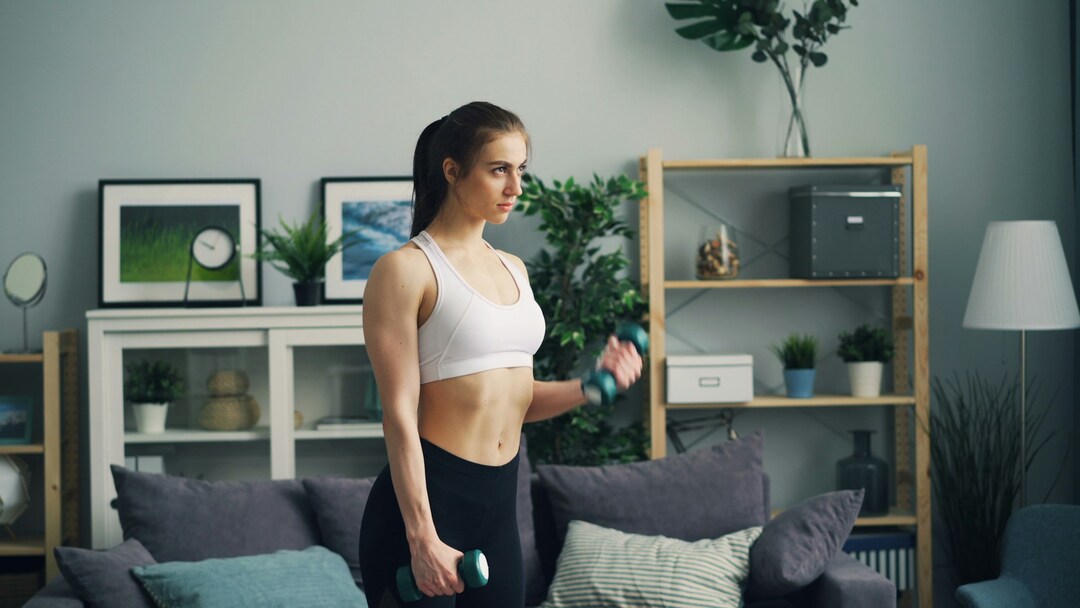18 Best Full Body Workouts For Women

Sculpt, tone, and feel stronger with this full-body workout for women, 18 effective routines to boost fitness and target every major muscle.
Ever scroll through Workout Apps For Women and feel overwhelmed by plans that do not fit your time or goals? A full-body workout for women should incorporate compound movements, core work, mobility exercises, HIIT training, and steady-state cardio to build strength, tone muscles, and improve endurance, whether you train at home, in the gym, or after pregnancy.
This guide provides clear, progressive routines, sample circuit workouts, equipment options, and no-equipment alternatives, as well as recovery tips, so you can feel empowered and stay consistent.
GetFit AI, an AI fitness app, turns those plans into personalized, easy-to-follow workouts, adapts as you improve, and keeps track of progress so you reach your strength, fat loss, and mobility goals without guesswork.
Summary
- The article frames 18 foundational moves as a complete programming toolset, advising that rotating them strategically across 2 to 4 weekly sessions yields balanced muscle tone, improved movement quality, and durable conditioning.
- Full-body frequency delivers broad health returns, with 70% of women reporting improved overall health after adopting full-body workouts and a 30% lower risk of osteoporosis when training at least 3 times per week.
- Consistency hinges on measurable tracking; the guide recommends recording one simple metric per session (for example, RPE, bar speed, or top-set weight) and changing only one variable at a time so you can tell what actually moves the needle.
- Recovery is the gating factor for progress, so aim for 7 to 8 hours of sleep and prioritize daily protein targets. Consider a 5- to 7-day reduced-volume microcycle whenever technique or readiness indicators decline.
- Realistic timelines reduce churn: expect noticeable capacity gains in 2 to 4 weeks, clearer strength improvements in 6 to 8 weeks, and visible body-composition changes over 3 to 6 months when nutrition and load are consistent.
- Frequency and structure matter more than raw session count; the article contrasts a 3-day concentrated model with a 5-day option that includes two high-intensity strength sessions, and recommends planning in blocks of 6 to 12 weeks to manage progression and recovery.
- This is where GetFit AI fits in; it centralizes athlete-tested programming, auto-adjusts weekly loads based on ongoing performance data, and provides in-session cues and substitutions, allowing users to maintain the intended stimulus without rebuilding plans each week.
18 Best Full Body Workouts For Women

These 18 moves form a comprehensive toolset, not a checklist: each one fills a unique slot in full-body programming, allowing you to build strength, posture, and conditioning without guessing which exercises to keep. Use them strategically across two to four weekly sessions, and you'll achieve balanced muscle tone, improved movement quality, and cardio gains that last.
1. Deadlift
The Deadlift is a fundamental strength training move that engages the hamstrings, glutes, lower back, and core. It enhances overall power and is essential in many fitness routines for developing posterior chain strength.
How to do it
- Stand with your feet hip-width apart, holding the barbell over your mid-foot.
- Bend at the hips and knees to grip the barbell with your hands just outside your legs.
- Keep back flat, chest up, and lift by extending hips and knees.
- Lower the bar back to the floor with control.
- Sets and reps: 3 sets of 8 reps at 60 lbs.
2. Pull Up
Pull-ups challenge the upper body by working the back, shoulders, and biceps using body weight. Modifications are available for beginners to build up strength gradually.
How to do it
- Grip a pull-up bar with hands shoulder-width apart.
- Hang with arms fully extended.
- Pull your body upward until your chin passes the bar.
- Lower yourself slowly back to the start.
- Sets and reps: 4 sets of 6 reps.
3. Front Squat
The Front Squat targets the quadriceps more intensely by holding the barbell in front of the body, thereby improving strength, posture, and stability, all of which are necessary for athletic performance.
How to do it
- Position the barbell across the front of your shoulders.
- Keep your elbows high to support the bar.
- Squat down by bending knees and hips until thighs are parallel to the floor.
- Push through your heels to return to the starting position.
- Sets and reps: 3 sets of 8 reps at 50 lbs.
4. Barbell Bench Press
A classic upper-body strength exercise, the Barbell Bench Press primarily works the chest muscles while also engaging the shoulders and triceps. It is essential for building upper-body power.
How to do it
- Lie flat on a bench with the barbell racked above you.
- Grip the bar slightly wider than shoulder-width.
- Lower the bar slowly to your chest, keeping your elbows at approximately a 45-degree angle.
- Press the bar back up until your arms are fully extended.
- Sets and reps: 3 sets of 8 reps at a manageable weight like 45 lbs.
5. Cable Row
The Cable Row strengthens the back, shoulders, and biceps using a cable machine. It offers controlled resistance and supports proper posture during execution.
How to do it
- Sit at the cable row station with your feet on the platform and your knees slightly bent.
- Grab the handle with both hands.
- Pull the handle towards your abdomen, squeezing your shoulder blades together.
- Slowly return to the starting position without rounding your back.
- Sets and reps: 3 sets of 8 reps at 50 lbs.
6. Back Squat
The Back Squat is a foundational lower-body exercise that primarily targets the quadriceps, hamstrings, and glutes. It is widely used to build overall leg strength and muscle mass, making it a staple in many fitness routines, especially powerlifting.
How to do it
- Stand with feet shoulder-width apart under a squat rack, barbell resting on your upper back.
- Engage your core and keep your chest up.
- Lower your body by bending your knees and hips, aiming to get your thighs parallel to the ground.
- Push through your heels to return to the starting position.
- Sets and reps: 3 sets of 8 reps with moderate weight (e.g., 55 lbs).
7. Dumbbell Lunge
Adding dumbbells to lunges increases resistance and intensity, mainly targeting the quadriceps while improving balance and leg strength.
How to do it
- Stand upright, holding dumbbells at your sides.
- Step forward into a lunge until the front thigh is parallel to the floor.
- Push back tothe standing position and repeat with the other leg.
- Sets and reps: 3 sets of 8 reps per leg with 20 lbs dumbbells.
8. Dumbbell Fly
This exercise isolates the chest muscles, helping to promote muscle growth and balance. The Dumbbell Fly also recruits the shoulders for added support.
How to do it
- Lie flat on a bench holding dumbbells above your chest with a slight bend in your elbows.
- Slowly lower weights out to the sides in a wide arc.
- Bring dumbbells back together over the chest.
- Sets and reps: 3 sets of 8 reps at 15 lbs.
9. Dumbbell Bench Press
A beginner-friendly chest exercise, the Dumbbell Bench Press targets the chest, shoulders, and triceps, while improving balance and coordination between both sides of the body.
How to do it
- Lie on a flat bench holding dumbbells at chest level.
- Press the weights up until your arms are straight.
- Lower the dumbbells slowly to the starting position.
- Sets and reps: 3 sets of 8 reps with 20 lbs dumbbell
10. Dumbbell Rear Delt Raise
This shoulder exercise targets the rear deltoids, promoting balanced shoulder development and improving posture by focusing on the muscles at the back of the shoulders.
How to do it
- Stand with a slight bend in your hips, holding dumbbells.
- Raise weights out to the sides, keeping elbows slightly bent.
- Lower dumbbells back down with control.
- Sets and reps: 3 sets of 8 reps with 12.5 lbs dumbbells.
11. Dumbbell Row
The Dumbbell Row is an effective exercise for strengthening the back, shoulders, and biceps. It also engages the core muscles for stability and can be performed with minimal equipment.
How to do it
- Place one knee and hand on a flat bench for support.
- Hold a dumbbell in the opposite hand, allowing it to hang straight down.
- Pull the dumbbell towards your waist, squeezing your shoulder blades.
- Lower it slowly back to the starting position.
- Sets and reps: 3 sets of 8 reps per arm with 25 lbs dumbbells.
12. Barbell Incline Bench Press
This exercise targets the upper chest and shoulders more than the standard bench press. It helps create balanced chest development and stronger shoulders.
How to do it
- Set a bench at a 30-45 degree incline.
- Lie back and grasp the barbell slightly wider than shoulder-width.
- Lower the bar to upper chest level.
- Press upwards, fully extending your arms.
- Sets and reps: 3 sets of 8 reps, around 45 lbs.
13. Lat Pulldown
The lat pulldown exercises the back, shoulders, and biceps. It's an accessible alternative to pull-ups, allowing control over resistance, which is excellent for beginners.
How to do it
- Sit at the lat pulldown machine and grip the bar wider than shoulder-width.
- Pull the bar down to your upper chest while squeezing your shoulder blades.
- Slowly allow the bar to return to the starting position.
- Sets and reps: 3 sets of 8 reps at 60 lbs.
14. Leg Press
The Leg Press machine provides a stable way to build leg and thigh strength, focusing mainly on the quadriceps. It supports the back, making it suitable for controlled heavy lifting.
How to do it
- Sit in the leg press machine with feet shoulder-width apart on the platform.
- Push the platform away by extending your knees, but avoid locking them.
- Slowly bend knees to return to the platform near the starting position.
- Sets and reps: 3 sets of 8 reps at 100 lbs.
15. Burpee
Burpees are a dynamic full-body exercise that combines a squat, a plank, and a jump. They boost cardiovascular endurance and strength while challenging multiple muscle groups.
How to do it
- Begin in a standing position.
- Drop into a squat and place your hands on the floor.
- Kick your feet back into a plank position.
- Perform a push-up (optional).
- Jump feet back toward hands and explode upward into a jump.
- Sets and reps: 4 sets of 9 reps, modifiable to fitness level.
16. Goblet Squat
The Goblet Squat is a versatile lower-body exercise targeting the legs, glutes, quadriceps, hamstrings, hips, and core. Holding a dumbbell close to your chest helps maintain proper posture and engages the core throughout the movement.
How to do it
- Stand with feet shoulder-width apart, knees softly bent, holding a dumbbell vertically at your chest.
- Lower your hips by bending your knees until your thighs are parallel with the floor, pushing your knees out towards your toes.
- Press through your heels to return to a standing position.
- Sets and reps: 3 sets of 8-12 reps with a moderate dumbbell weight.
17. Single Arm Back Row
This exercise focuses on the latissimus dorsi (lats) and core by adding a balance challenge, which helps to improve unilateral strength, stability, and posture.
How to do it
- Stand with feet shoulder-width apart, knees slightly bent.
- Hold a dumbbell in your right hand at your side, palm facing inward.
- Rest your left fingers on a dumbbell placed vertically on the floor for balance.
- Hinge forward at the hips until your torso is parallel to the floor, extending your right leg straight back.
- Pull your right elbow back toward your rib cage, squeezing your back while keeping your shoulders down.
- Lower the dumbbell slowly with control.
- Sets and reps: 3 sets of 8 reps per side.
18. Reverse Lunge and Bicep Curl
Combining a lower-body lunge with an upper-body bicep curl, this compound move simultaneously engages the legs, glutes, quadriceps, core, arms, and biceps, improving strength and coordination.
How to do it
- Stand with feet hip-width apart, holding dumbbells at your sides.
- Step your left leg back into a reverse lunge, lowering until both knees form 90-degree angles.
- As you lunge down, perform a bicep curl by lifting dumbbells to shoulder height.
- Hold the lunge position as you lower the dumbbells under control.
- Drive through your right heel to return to standing.
- Repeat on the other leg.
- Sets and reps: 3 sets of 8 reps per leg with moderate dumbbells.
How should you sequence these across the week?
Alternate heavy bilateral days with lighter unilateral or conditioning sessions, keeping the most technical lifts early and finishing with controlled isolation or conditioning. That approach preserves technique, reduces the risk of injury, and maintains a consistent weekly volume.
Why not just follow a hodgepodge of classes and trends?
Most people stick with what’s familiar because it feels manageable, but that creates hidden friction: inconsistent load progression, mismatched volume, and slow technique gains as workouts compete for recovery. In fact, a 2021 study, "Sixty-seven untrained subjects were randomized to one of two groups.", examined these program structures and used a specific "Split Workout Routine (n=35), in which muscle groups were trained..." to represent split programming, showing researchers the tradeoffs between approaches in a controlled way.
How can you maintain progress that is both measurable and consistent?
Track simple metrics each session, like RPE, bar speed, and a rep-in-reserve record. When volume, frequency, and movement selection are transparent, you stop guessing and start compounding gains week to week.
Most teams manage training plans using spreadsheets or randomized class mixes because these options are familiar and low-friction. Still, as training frequency and individual differences increase, this approach fragments recovery and stalls progress. Solutions like GetFit AI centralize programming, automatically adjust weekly loads based on ongoing performance, and offer in-session cues and substitutions, providing coaches and athletes with a consistent way to scale athlete-tested routines without additional administration.
A quick coaching note on typical failure modes
The pattern that ends progress is predictable: you add isolated intensity without adjusting your weekly volume, ignore unilateral gaps until they cause pain, or push conditioning so hard that it blunts your strength. Fix any one of those, and you reclaim months of progress.
I know many women come to training because they want to improve their strength, posture, and achieve a balanced physique. I observe the same behavior across programs: workouts often include burpees and lunges because they deliver both cardiovascular and muscle-toning benefits efficiently. That motivation should shape how you program: prioritize compound lifts for strength, incorporate metabolic work for conditioning, and utilize unilateral moves to enhance posture and symmetry.
You want the whole plan? Continue reading to determine whether these comprehensive approaches actually deliver the results they promise.
Are Full-Body Workouts Effective for Women?

Full-body workouts are highly effective for women when programmed with clear progression, appropriate recovery, and variety of movements, as they deliver significant systemic benefits for relatively little time investment. When you stack frequency, load progression, and technique cues correctly, strength, conditioning, and everyday function improve together, not in isolation.
Why do many women see faster, broader gains from full-body schedules?
Pattern recognition reveals that full-body frequency forces provide regular, repeated stimulation of major muscle groups, which accelerates neuromuscular learning and metabolic adaptation. A 2025 analysis by 1st Optimal, 70% of women reported improved overall health after incorporating full body workouts, supporting what we see in practice: consistency across compound lifts translates to improvements that extend beyond aesthetics, into sleep, energy, and daily resilience.
How does training frequency change long-term health outcomes?
The critical constraint is frequency paired with progressive loading. Programs that hit full-body work three times weekly deliver not just short-term strength gains but measurable bone protection, and that matters: a 2025 report by 1st Optimal shows that Women who engage in full-body workouts at least 3 times a week have a 30% lower risk of developing osteoporosis, which shows this is a preventive strategy, not an optional extra. Frequency generates repeated osteogenic signals, and these small, repeated stresses accumulate over time.
What typically breaks progress, and how do you avoid it?
Problem-first: inconsistency kills compounding. The usual pattern involves trying new moves every week, chasing burnout with excessive conditioning, or layering high-intensity classes onto heavy lifting without scaling the volume. When that happens, recovery gets crushed and strength stalls. Treat progress like compound interest, make small, predictable deposits each session, and avoid one-off intensity spikes that wipe out subsequent training quality.
Most women piece together workouts from classes, apps, and advice because that approach feels flexible and familiar. That familiarity works until planning friction turns into missed progression, and weeks blur into plateaus. Solutions like GetFit AI act as a bridge here, as they centralize athlete-tested programming, auto-adjust weekly loads based on performance, and offer in-session cues or substitutions when constraints arise, allowing users to maintain the intended stimulus without rebuilding the plan every week.
If you only have a few hours a week, where should you focus your energy?
Constraint-based thinking helps: prioritize movements that load multiple joints under control, then use short, high-quality sets to maintain intensity. When time is the limit, microprogressions matter more than long sets. Add a 2.5% load when the technique remains clean. Use short cluster sets to preserve intent on heavy days, and employ autoregulation by reducing sets when bar speed or perceived exertion begins to slip. That way, every minute in the gym buys durable progress, not temporary soreness.
How can you support recovery so the program continues to work effectively?
Specific experience shows nutritional and sleep buffers change outcomes more than fancy programming tweaks. Aim for a consistent protein intake throughout the day, prioritize 7 to 8 hours of sleep when possible, and schedule low-effort mobility or active recovery on off days to maintain high circulation and readiness. Think of recovery as the ledger that validates every training deposit; if it is neglected, the account balance never grows.
The frustrating part is that efficiency and effectiveness reside on opposite sides of a thin line, and a slight programming choice can push you from one to the other.
Related Reading
• Upper Body Workout For Women
• Leg Day Workout for Women
• Beginners' Workout For Women
• Average Deadlift Weight Kg Woman
What is a Good Full Body Workout Routine To Do At Home?

A compact, practical at-home full-body session pairs a clear strength focus with short, high-quality conditioning and simple progression rules, so every workout moves the needle. Build each session around two compound efforts, one unilateral or stability challenge, and a short core or metabolic finisher. Then, track a straightforward metric to determine if you've improved.
How should I structure a single workout?
Start with 5 to 8 minutes of movement-specific warm-up that raises heart rate and rehearses the exact patterns you will load. Treat the main block like two priority slots: a heavier multi-joint effort for strength, followed by a controlled volume movement for muscle and movement quality. Finish with a focused 6- to 10-minute finisher that either raises conditioning or targets core endurance, then cool down with mobility exercises that restore the position you just stressed.
What intensity and rep ranges actually move you forward?
Use a small menu of effort bands: heavy work in the 4-8 rep range for neural and strength gains, moderate work in the 8-15 rep range for hypertrophy and control, and higher rep or timed sets for metabolic stress and endurance. Rest to match intent, longer for strength, shorter for metabolic sets. Track one metric per session, like top set weight, reps completed, or a 6-minute conditioning score, and make only one small change when that metric stalls.
How can I make tough sessions feel more challenging without using extra equipment?
Progress by changing leverage, tempo, and density, not only load. Slow the eccentric, add a 2 to 4 second pause at the weak point, or turn a set into a ladder or paired superset to increase time under tension. Minor tweaks, such as a 10- to 20-second tempo shift or switching to a single-leg variation, multiply stimulus without needing heavier weights.
Why does variety matter, and how much should you plan?
Variety prevents boredom and entrenched imbalances, but it must be deliberate and intentional. Men’s Health 2025 outlines five full-body workouts that you can cycle through on a monthly rotation, each emphasizing different tempos, rep ranges, and conditioning methods, allowing the body to adapt without constant novelty.
Most people stitch workouts together because it feels flexible, and that makes sense.
The familiar approach works until hidden costs appear, such as mismatched weekly loads, conflicting intensities, and slow, measurable progress. Platforms like AI fitness apps centralize athlete-tested templates, automatically adjust the weekly load based on your tracked performance, and deliver in-session cues and substitutions, so you can maintain the intended stimulus without rebuilding the plan every week.
How do you stop motivation from drifting at home?
This challenge appears across home programs and gym plans: lack of structure and accountability erodes momentum more than any missing piece of equipment. Achieve small, visible wins each week, such as a one-rep improvement, a tighter tempo, or a timed finisher score. Those short targets transform vague intentions into measurable progress and reduce the emotional drag of “where do I start” into a short to-do list you can check off.
Where should conditioning live in a full-body session?
Place conditioning after your strength priorities or on a separate, shorter day to achieve maximal strength returns. When done correctly, a high-effort conditioning block provides both metabolic benefits and time-efficient calorie burn, which explains why some intense templates can reach up to 1,200 calories burned per session on demanding days. Use brief, scored conditioning tests to accurately measure both aerobic and anaerobic improvements, without relying on subjective estimates.
How should you manage recovery and weekly load?
Progress happens when stimulus meets recovery. When you experience persistent technique decay, prolonged soreness, or increased perceived effort for the same work, reduce volume or intensity for a microcycle of 5 to 7 days—track readiness with a simple pre-session checklist: sleep, appetite, movement quality, and perceived recovery. If two of those are poor, choose a maintenance session with focused technique and mobility rather than forcing a heavy day.
Ready to train like the legends and finally achieve the body you've always wanted? GetFit AI's AI fitness trainer app lets you follow the exact workout routines that made Arnold Schwarzenegger, Kobe Bryant, Cristiano Ronaldo, Serena Williams, and 11+ other elite athletes into champions, and you can also chat with them whenever you need guidance or motivation. Download the #1 rated AI fitness app for free today to get fit for less than the cost of a single month's gym membership. Because greatness isn't born, it's built one workout at a time.
That solution feels complete until you realize the single scheduling choice you make each week quietly controls every outcome that follows.
How Many Days in a Week Should You Do a Full Body Workout?
There is no single correct number of training days; it depends on your goals, recovery capacity, and how you structure the week. Many women opt for either a focused three-day model or a higher-frequency five-day approach, depending on their priorities. The phrases' 3 days a week' and '5 days a week' capture the practical range you will choose between recovery-first progress and frequent conditioning density.
How should you let recovery steer frequency?
Pattern recognition shows progress stalls when people ignore recovery signals early. Use simple, measurable checks each morning, such as sleep quality, resting heart rate compared to baseline, and movement quality during a brief warm-up. If two of those metrics are degraded for 48 to 72 hours, treat the day as a maintenance session, not an opportunity to pile on volume. That rule protects technique and prevents the slow bleed of chronic fatigue that masquerades as “tough training.”
When does adding a training day actually help?
Constraint-based thinking helps here: add a day when your goal demands increased practice density, such as improving bar speed or conditioning, and your recovery metrics remain stable over two full microcycles. If your goal is neural strength, prioritize intensity and lower the frequency. If skill or metabolic conditioning is the objective, shorter, more frequent sessions are more effective than one long session because they allow you to rehearse movement quality without overexerting the nervous system.
What does a practical microcycle look like?
After programming multiple 6- to 12-week blocks, the pattern became clear: structure wins over raw days. Try a 5-day option with two higher-intensity strength sessions, two short technical or mobility sessions, and one conditioning session, or a 3-day block that focuses on heavier compound efforts and leaves two full recovery days. The choice is an implementation detail; the principle remains the same: track one metric per session and change only one variable at a time, so you can determine what actually moved the needle.
What mistakes throw frequency off-course?
Problem-first: people equate more sessions with faster results, then layer classes, long finishers, and heavy lifts until movement quality breaks down. The failure mode looks like rising soreness, sloppy technique, and stalled lifts. Fix it by capping weekly complex sets for each significant lift and by autoregulating volume with RPE or reps in reserve, so the weekly training stimulus increases only when recovery supports it.
Most people stitch workouts from classes, apps, and random plans because it feels flexible and familiar. That approach works at first, but as volume and lifestyle stressors rise, planning friction fragments recovery and hides whether the stimulus is productive. Solutions like GetFit AI centralize athlete-tested programming, automatically adjusting the weekly load based on tracked performance, and offer in-session cueing and substitutions, keeping the intended stimulus consistent while removing the guesswork that causes overtraining and wasted sessions.
A quick analogy to keep this practical: treat your weekly program like a garden, not a furnace. Water and feed it often, but in measured amounts, so nothing drowns or burns out.
That choice about how many days to train quietly controls every outcome that follows — and there is one detail most people miss next.
Related Reading
• Free Workout Apps For Women
• Workout Plans For Women
• Workout Routine For Women
What are the Benefits of a Full-Body Workout For Women?
Full-body workouts deliver outsized results for women because every session combines strength, metabolic efficiency, and cardiovascular stimulus into one compact block, allowing you to achieve measurable gains without spending endless hours in the gym. They change how you move, how you recover, and how your body responds to daily stressors, and those changes compound week to week when programmed smartly.
How do full-body sessions affect hormones, sleep, and daily energy?
This pattern appears consistently when women move from sporadic workouts to three focused full-body sessions a week: insulin sensitivity improves, midday crashes become less common, and sleep quality stabilizes. That improvement is not mystical; it is the result of repeated multi-joint loading and short, intense conditioning that, together, lower systemic inflammation and normalize energy swings throughout the cycle.
Won't I get bulky if I lift regularly?
That worry is common, but the real picture is different. When you prioritize frequency and technical loading over maximal single-rep ego lifts, you build lean, functional muscle that improves shape and performance without the oversized look most people fear. In fact, Women who engage in regular full-body workouts can increase their muscle mass by up to 20% within a year. That gain typically translates into stronger, more efficient movement rather than bulk. Also, remember that a higher healthy body fat range supports performance, as women perform best with body fat levels closer to 15 to 22 percent, rather than the ultra-lean targets often promoted as ideal.
How much does full-body training protect your heart over time?
Think of full-body sessions as practical cardiac insurance, because they deliver regular aerobic load alongside strength stimulus in the same training hour. Regular full-body workouts can improve cardiovascular health by reducing the risk of heart disease by 30%, demonstrating that this is more than just fitness bragging; it is a proven prevention strategy. Sustained reductions in resting blood pressure and improved lipid profiles follow consistent mixed-modality work over several months.
How does this reduce injury and improve movement durability?
Pattern-based coaching shows that balanced, repeated exposure to compound lifts changes tissue quality. When you follow progressive loading with attention to tempo and joint position for 8 to 12 weeks, tendons and ligaments adapt, motor patterns stabilize, and common flare-ups around the knee and shoulder subside. The failure mode I observe is conducting isolated, max-effort sessions without a plan for tissue capacity; the solution is a gradual load increase, controlled density, and deliberate single-leg or anti-rotation work to build resilience.
Most women assemble workouts from varied sources because it feels flexible and doable, especially on busy weeks. That familiar approach works well early on, but as weekly stresses and goals accumulate, the mismatch between intensity and recovery becomes more pronounced, and progress stalls. Platforms like GetFit AI centralize athlete-tested programming, automatically adjust weekly loads based on ongoing performance data, and deliver in-session cues and substitutions, allowing users to maintain consistent, measurable progress without spending hours rebuilding a plan.
How quickly will you feel different, and what should you track?
Expect an early jump in confidence and daily capacity within 2 to 4 weeks, clearer strength improvements in 6 to 8 weeks, and noticeable body-composition shifts by 3 to 6 months when nutrition matches effort. Treat progress like tuning a guitar: minor, regular adjustments to load, tempo, or frequency keep the instrument in tune; big, sudden changes snap strings. Track one simple performance metric each week, then change only one variable when it stalls.
That old, scattershot way of training feels familiar, but it quietly costs you months of meaningful progress.
The next part will reveal the surprising step that makes elite-level coaching feel personal, not out of reach.
Make Your Favorite Athlete Your Fitness Trainer | Try GetFit AI's AI Trainer App for Free Today
If you want structured, full-body training that actually makes a difference, consider GetFit AI as a practical way to stop guessing and start tracking measurable progress. Patchwork plans can feel familiar but quietly stall progress. So, note that GetFit AI, with 90% of users reporting improved fitness levels within three months, and over 1 million downloads, together signal both rapid improvement and broad, real-world adoption.
Related Reading
• Ab Workout Women
• Arms Workout for Women
• Lower Abs Workout for Women
• Hiit Workout Women



.png)











